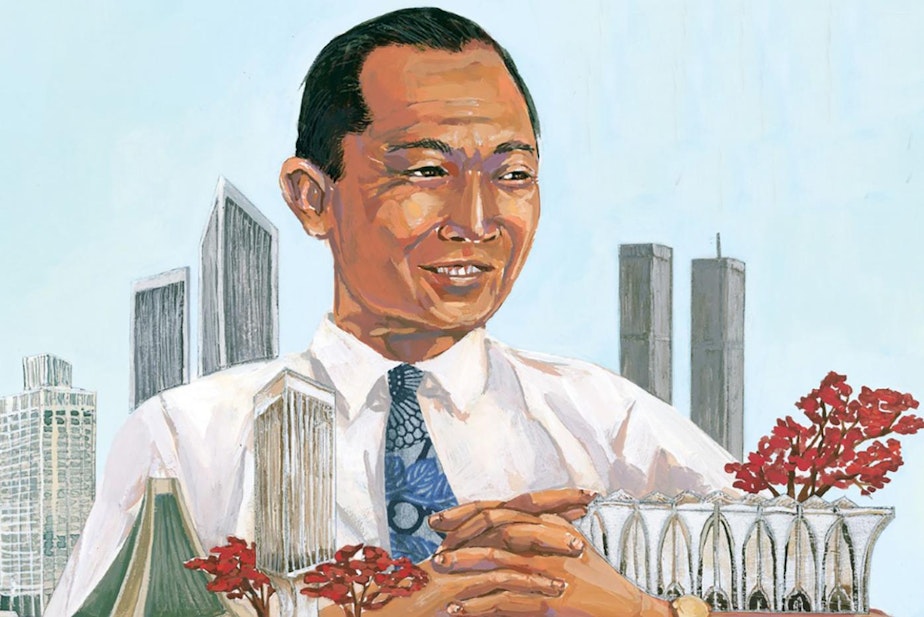Serenity, surprise, and delight: sharing the legacy of architect Minoru Yamasaki

Seattle-born Minoru Yamasaki was one of the most prominent American architects of the 20th Century, best known for designing the first World Trade Center.
Now, his granddaughter Katie Yamasaki is sharing his story with new generations of would-be architects. She’s the author and illustrator of “Shapes, Lines and Light: My Grandfather’s American Journey,” a new book about Minoru Yamasaki's life and work.
Katie spoke with Soundside producer Noel Gasca about the process of writing about her grandfather, and also the experience of racism and exclusion that shaped her grandfather's work.
Noel Gasca: When did you become aware of your grandfather's place in the architecture world?
Katie Yamasaki: It's interesting to think about his place in the architecture world because he's kind of most known for two projects that least represent him in terms of his artistry and in terms of kind of who he was as a person. One being the World Trade Center, and one being Pruitt-Igoe.
In places like Seattle and in places like Detroit, he's extremely famous. But if you go to architecture schools around the country, it wasn't until fairly recently that his work was even taught. I would meet people who worked in architecture, and they would say things like, 'Oh, Yamasaki, World Trade Center, and Pruitt-Igoe, what a tricky legacy.' And I was thinking, in my life, I kind of knew him as this larger-than-life presence for his accomplishments. But that wasn't necessarily how the world encountered him. And I wanted to kind of create a space in this book for exploring who he was as an artist and getting to understand his intentions with his work, especially in the context that he grew up in as a Japanese American man in this country.
How long have you wanted to tell the story of your grandfather's life? And why did you decide to tell the story through the format of a children's picture book in particular?
Sponsored
I've wanted to tell this story for a very long time. When we were growing up, we lived in a factory town north of Detroit, and it was very specifically an anti-Japanese place at an anti-Japanese time. It was during the recession, Vincent Chin was murdered when I was 6 years old, it was kind of a tricky place to grow up, as [a] mixed race, Japanese American family.
But it was also strange, because we knew our grandfather was famous. And so there was this kind of feeling of being at odds with the popular narrative of what it was to be Japanese and who the Japanese were. But I've always wanted to kind of tell his story, because the backstory of being Japanese American growing up in this country being born in 1912, and kind of building a career in post-war America — when the Japanese American community has lost everything — it's a profound story.
I started graduate school at the School of Visual Arts in 2001. 9/11 was like our second day of school. And I remember watching as his buildings — the World Trade Center, got turned into ... this piece of pro-war propaganda for war that we didn't agree with, a war that we didn't support. And it made me think a lot about the symbols that we make, and the stories that are told about our work when it might not be the story that we want.
You write about the ethos that drove your grandfather's work and you write, "The spaces he built connected to the humanity of everyday people, workplaces, learning spaces, travel hubs, and sacred spots to gather were filled with serenity, surprise, and delight."
Why do you think your grandfather was inspired by those three words?
Sponsored
I think he knew that everybody, no matter your life circumstances, deserves those three things: serenity, surprise, and delight. And it's a human desire to have all of those things.
And when he would make spaces at universities or at airports, or at religious, sacred spots, that was his way that he could provide people maybe what he wasn't always allowed to experience when he was a young man himself, or what his parents as immigrants were allowed to experience. His father worked his entire life stacking shoes in the back of shoe stores. He was an incredible worker but he was never allowed to sell the shoes or be out on the floor. And you think about how our lives are enriched by these elements of peace or of surprise and delight. And I think that at his best, and at his most ideal, those were the things that he wanted to bring to the world. Those were the gifts he knew he could impart after he did the World Trade Center.
Listen to the full interview above






